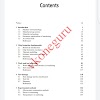Basic of electrical engineering book by C L Wadhwa & Power electronics hand written NOTES FROM MADE EASY DELHI for Gate exam, IES and any university exam....
IntroductionDC CIRCUIT
INTERNATIONAL SYSTEM OF UNITS :
The international system of units abbreviated as SI has been universally accepted forinternational use in all fields of engineering and day to day requirements. Therefore, all business
and even household transactions are conducted in SI units. SI system offers the following
advantages over other system of units.
1. There is one and only one unit for each physical quantity. Therefore, a table of
conversions from one unit to another is not required.
2. The system is coherent with the derived units. The conversion factor from the original
unit to the derived unit is simply a multiplication or division by 1.
3. There are no conversions between electrical and mechanical systems e.g. a motor or
an automobile engine is now rated as in kW rather than horse power. Energy is now
expressed in watt-sec rather than in Joule etc.
There are a large number of quantities (more than thirty) which an electrical engineer
deals in. However it is not necessary to assign a standard unit to each quantity as these quantities
are functionally related through experiments, mathematical derivation or definitions. The
minimum number of quantities required to express the units of all other quantities are known
as fundamental quantities. The following are the considerations for selection of fundamental
quantities.
(i) A minimum number of constant should be required to establish relationship between
the various quantities involved in the study of the given discipline.
(ii) The measuring units shall he of a practical size.
There are seven fundamental units which are listed below with their name, quantity symbol
and unit symbol.
1. Length-metre, l, m
It is defined in terms of wavelengths of a particular radiation from krypton 86.
2. Mass-kilogram, m kg
It is defined equal to the mass of the international prototype kept in Sevres, France.
3. Time-seconds, t, s
It is defined in terms of the duration of a specific number of periods of a particular
radiation from the cesium-133 atom.
4. Current-ampere, I, A
It is defined as the constant electric current in two infinite parallel conductors
separated from each other by 1 m, produce a force of 2 x 10-9 Nim.
RESISTANCE
We know that a random motion of free electrons results from the exchange of the outer orbit
between the atoms. In order to establish a net or average flow of electrons in one direction an
external force is necessary. This force is necessary to overcome a resistance. If the material is a
good conductor of electric charges, relatively smaller force is required to produce a current flow.
Copper and silver are good conductors. Silver is better conductor than copper.
A good insulator is one which effectively eliminates the flow of current of any practical
magnitude. Polystyrene is a good insulator and has approximately 3 x 101
8 free electrons per
cubic metre. Materials which have 1021 to 1025 free electrons per cubic metre are known as
semiconductors.
Click here to downloadBasic of electrical engineering by C L Wadhwa
Click here to downloadPower electronics hand written NOTES FROM MADE EASY DELHI
Comments for any books with subject name and writter name...
We try to give you best..
For regular updates you must verify your email id...
Thanks
Please subscribe and follow us vkoneguru
You can search on Google also vkoneguru and follow us..








0 Comments